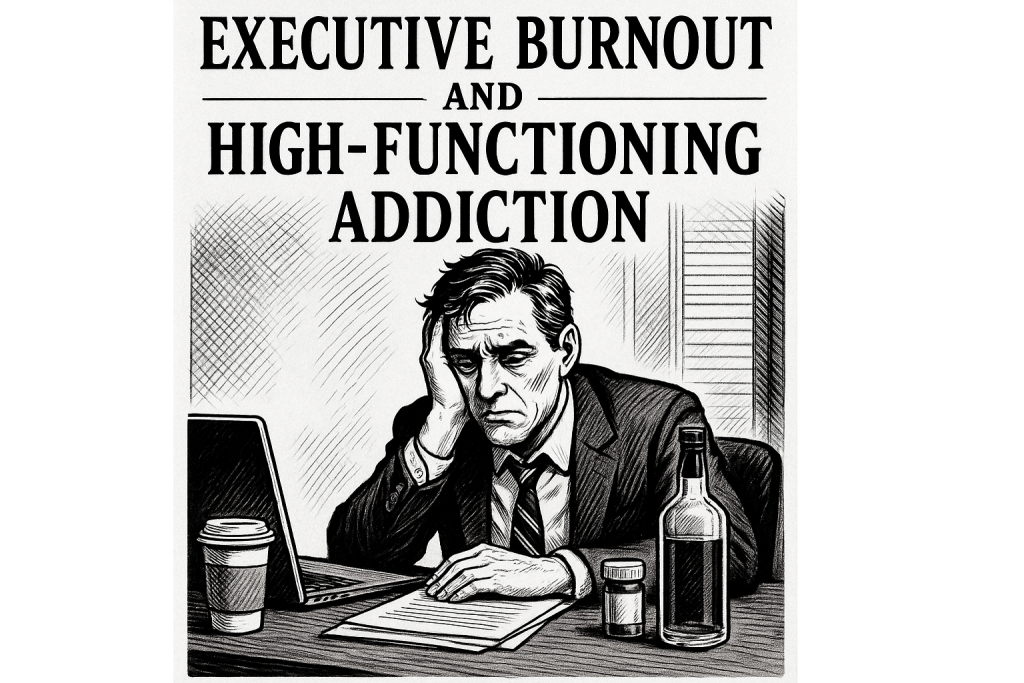In today’s fast-paced corporate world, the line between dedication and obsession often blurs, leading to a perilous journey towards executive burnout and high-functioning addiction. The pressure to perform and succeed can drive executives to adopt unhealthy coping mechanisms, often leading to substance abuse or behavioral addictions that remain hidden beneath a veneer of success. This blog post delves into the hidden struggles of executive burnout and high-functioning addiction, offering insights and solutions for those seeking recovery.

Understanding Executive Burnout
Executive burnout is a state of physical, emotional, and mental exhaustion caused by prolonged and excessive stress. It is characterized by feelings of being overwhelmed, emotionally drained, and unable to meet constant demands. According to the World Health Organization (WHO), burnout results from chronic workplace stress that has not been successfully managed (source: WHO). Key symptoms include:
- Emotional Exhaustion: Feeling drained and depleted of emotional resources.
- Depersonalization: Developing a cynical attitude towards work and colleagues.
- Reduced Personal Accomplishment: Experiencing a decline in productivity and feeling unfulfilled.
Executives often face unique pressures, such as high-stakes decision-making, long hours, and the constant drive to meet and exceed goals. These factors contribute significantly to burnout, which, if left unaddressed, can lead to more severe issues like high-functioning addiction.
The Reality of High-Functioning Addiction
High-functioning addiction occurs when individuals maintain a facade of normalcy while privately struggling with substance abuse or behavioral addictions. Unlike stereotypical portrayals of addiction, high-functioning individuals often perform well in their professional roles, making it challenging to identify the problem. The National Institute on Drug Abuse (NIDA) emphasizes that addiction is a complex disease that affects the brain’s structure and function, altering an individual’s ability to make decisions (source: NIDA).
Common signs of high-functioning addiction include:
- Secretive Behavior: Concealing substance use or downplaying its impact.
- Rationalization: Justifying addictive behavior as a means to cope with stress.
- Increased Tolerance: Needing more of the substance to achieve the same effects.
It’s crucial to recognize that high-functioning addiction is not a sustainable lifestyle and can lead to detrimental effects on physical and mental health, relationships, and career.
Seeking Help: The Role of Luxury Rehab
Recognizing the need for help is the first step towards recovery. Luxury Rehab serves as a referral source for top-tier rehabilitation centers in California, specializing in executive burnout and high-functioning addiction. Our mission is to connect individuals with five-star treatment facilities that offer comprehensive care in superior surroundings.
Why Choose a Luxury Rehabilitation Center?
- Individualized Treatment: Luxury rehabs offer personalized programs tailored to meet the unique needs of each client. This includes one-on-one treatment sessions and structured group therapy, ensuring a balance between individual and collective healing.
- World-Class Amenities: Facilities provide a serene and secure environment with amenities like yoga, Tai Chi, art therapy, and music therapy, promoting a holistic approach to recovery.
- Expert Staff: The centers we refer to boast highly qualified staff with master’s level degrees in social work or behavioral science, ensuring expertise in addiction treatment and behavioral modification.
Conclusion
Executive burnout and high-functioning addiction are pressing issues that require immediate attention and action. With the right support and treatment, recovery is not only possible but can lead to a more balanced and fulfilling life. At Luxury Rehab, we are committed to guiding you towards the best rehabilitation centers that prioritize your well-being and success. If you or someone you know is struggling, reach out to us today to begin the journey to recovery and rediscover the path to a healthier, happier life.
Sources:




